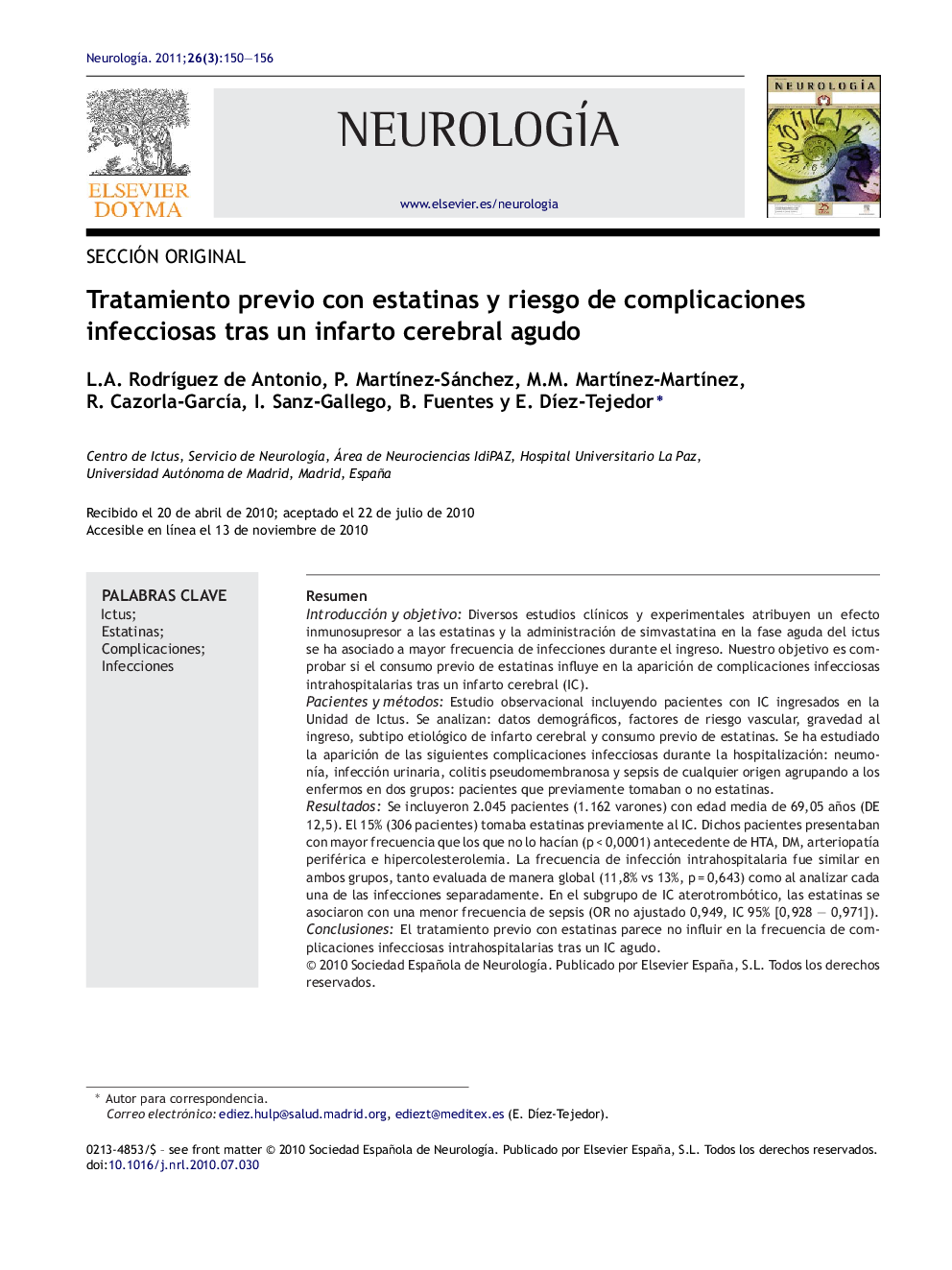| Article ID | Journal | Published Year | Pages | File Type |
|---|---|---|---|---|
| 3076434 | Neurología | 2011 | 7 Pages |
ResumenIntroducción y objetivoDiversos estudios clínicos y experimentales atribuyen un efecto inmunosupresor a las estatinas y la administración de simvastatina en la fase aguda del ictus se ha asociado a mayor frecuencia de infecciones durante el ingreso. Nuestro objetivo es comprobar si el consumo previo de estatinas influye en la aparición de complicaciones infecciosas intrahospitalarias tras un infarto cerebral (IC).Pacientes y métodosEstudio observacional incluyendo pacientes con IC ingresados en la Unidad de Ictus. Se analizan: datos demográficos, factores de riesgo vascular, gravedad al ingreso, subtipo etiológico de infarto cerebral y consumo previo de estatinas. Se ha estudiado la aparición de las siguientes complicaciones infecciosas durante la hospitalización: neumonía, infección urinaria, colitis pseudomembranosa y sepsis de cualquier origen agrupando a los enfermos en dos grupos: pacientes que previamente tomaban o no estatinas.ResultadosSe incluyeron 2.045 pacientes (1.162 varones) con edad media de 69,05 años (DE 12,5). El 15% (306 pacientes) tomaba estatinas previamente al IC. Dichos pacientes presentaban con mayor frecuencia que los que no lo hacían (p < 0,0001) antecedente de HTA, DM, arteriopatía periférica e hipercolesterolemia. La frecuencia de infección intrahospitalaria fue similar en ambos grupos, tanto evaluada de manera global (11,8% vs 13%, p = 0,643) como al analizar cada una de las infecciones separadamente. En el subgrupo de IC aterotrombótico, las estatinas se asociaron con una menor frecuencia de sepsis (OR no ajustado 0,949, IC 95% [0,928 – 0,971]).ConclusionesEl tratamiento previo con estatinas parece no influir en la frecuencia de complicaciones infecciosas intrahospitalarias tras un IC agudo.
IntroductionClinical and laboratory studies have attributed an inmuno-supressor effect to the statins. Furthermore, the administration of simvastatin in the acute onset of stroke has been associated with an increased infection frequency. Our objective is to assess the influence of statins previous treatment on infection after ischemic stroke.Patients and methodsObservational study of patients with ischaemic stroke hospitalised in a Stroke Unit. Demographic data, vascular risk factors, stroke severity, stroke subtype and previous statins treatment were evaluated. The following infections were registered: pneumonia, urinary tract infection, pseudomembranous colitis and sepsis. The patients were classified into two groups, depending on previous statin treatment.ResultsA total of 2045 patients were included (1165 were male, aged 69.05 ± 12.5 years). Of these, 306 (15%) patients were receiving statins prior to stroke. These patients had more frequently arterial hypertension, DM, peripheral arterial disease and hypercholesterolaemia than the patients who were not treated with statins (P < 0001). There was no statistically significant difference between overall in-hospital infection frequency between patients treated with statins and those with no statins treatment, (11.8% vs. 13%), nor in individual infection type: pneumonia (7.8% vs. 10.2%), urinary tract infection (4.2% vs. 2.8%), pseudomembranous colitis (0.3% vs. 0.7%) and sepsis (2.6% vs. 4.4%). In the atherothrombotic stroke subtype, statins were associated with a lower frequency of sepsis (unadjusted OR, 0.949; 95% CI; 0.928-0.971).ConclusionsPrevious treatment with statins does not appear to influence the frequency of in-hospital infections in patients with ischaemic stroke.
